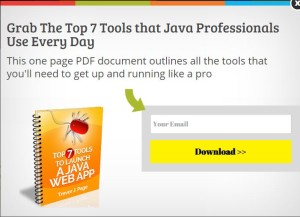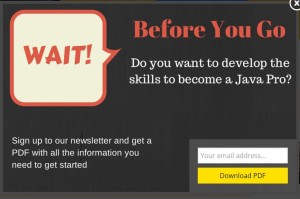In the almost 3 years that I’ve been doing business online, I’ve learned the same lesson over and over again.
Sending “cold” traffic directly to a sales page doesn’t work. Period.
What is “cold” traffic? I define cold traffic as people who aren’t familiar with you or your brand that land on your website.
So take a moment to think about this yourself. You do a Google search for something like “comfortable headphones”, and the first result you click on send you to a page with some headphones, a price tag and a buy button.
In all honesty, what’s the likelihood that you’re going to click that buy button and follow through with an order? My guess is, not very likely.
You need to turn “cold” traffic into “warm” traffic. For the example of someone searching for “comfortable headphones” it might make more sense for you to have an article that reviews different types of comfortable headphones, and perhaps on of them are yours (if you’re selling headphones that you’re making) or you could have affiliate links to all the headphones listed. Whatever the case may be, the main point of the website shifts from selling headphones, to talking about headphones.
If you’re in the information product space (like I am), then your website should focus on capturing “cold” traffic into an email list. We’ve talked about this tactic before back in Episode 1, so I won’t go into lead magnets right now.
Your Email List is Key
Getting emails from your cold traffic and turning them into warm leads is the name of the game. The first step of this process is to GET them on your list. That’s what we’ll focus on right now.
There are several things you can do to focus on email list growth. I’ll present a few things that helped me double my email list growth, then I’ll present ONE other thing that helped me double it AGAIN.
So, first thing’s first. We’ll need to focus on the “generic” things that more or less every successful blogger does to help grow their email list.
#1 – Popups
I know, I know, nobody likes popups, but like I said in a previous episode:
There’s a reason why everyone uses popups… they work!
Now, if you don’t like the idea of hammering your audience with a popup the moment they land on your site, then so be it. There’s a few things you can do.
There’s all sorts of wordpress plugins that allow you to create popups and control how / when they appear. But by far the coolest one I’ve used (and the one that has the most features) is Optin Monster.
Optin Monster allows you to create a regular old popup with a customizable delay. So you can have it popup immediately or you can have it pop up “X” number of seconds after they’ve landed on your blog.
My recommendation would be to just test a bunch of timing options. The cool thing about Optin Monster is that they allow you to split test very easily. So you’ll be able to see EXACTLY which of the variations convert the most amount of people to your email list.
Right now I have my popup set to display after 60 seconds. This way it’s a little bit less intrusive to my visitors and it’ll really only display for the people who are ACTUALLY engaged with my website’s content.
After about 55,000 impressions, this popup converts at around 2.76%. Here’s what it looks like:
#2 – Exit Popups
Yet again, another type of popup!
This one’s a bit different though, the exit intent popup only displays when someone moves their mouse towards the top of the browser. This typically denotes that they’re moving their mouse towards the “back” button or the “close” button – thus indicating that they’re going to leave your website.
This type of popup tends to convert better, as it’s a neat little “pattern interrupt” for people. Normally, people are so used to seeing popups as soon as they land on a website (or at some point after they’ve already been on the site) so they’re conditioned to just “close” the popup without reading it… even if the popup offers something of value.
The nice thing about exit intent popups is that they tend to work a little bit better and force the website visitor to actually “take notice” of the popup.
This “exit intent” feature is built into the Pro plan of the Optin Monster wordpress plugin. At the time of the posting of this article, the Pro version goes for $199. This might seem a bit steep for some people considering it’s just a wordpress plugin, but trust me, it’s so worth the money.
My exit intent popup has received about 40,000 impressions and is converting at 3.66%. That’s about a 33% improvement over my regular popup. So the question that you’ll need to ask yourself is this: “Is converting 33% MORE of my cold traffic worth a one time $199 investment?”
To me the answer is obvious, since I’ve already made the investment and am advising you to do the same. Totally worth it!
By the way, here’s what my exit intent popup looks like:
Okay, let’s move onto the next type of email capture you should implement on your website.
#3 – After Post Email Capture
Another great spot to capture emails is after your blog posts. I think you should always have a call to action at the end of each blog post that asks people to sign up for your email list. Because if someone has made it through your entire article and read every word, they’ll likely be interested in signing up for your list.
So don’t lose out on these people. Sure you won’t get a TON of signups here, but these people may be the most engaged people that you add to your list.
Again, the go to plugin here is Optin Monster! Shocker isn’t it?
It’s called an After Post Popup and it’s just a little box that displays (automatically) at the end of each of your blog posts.
Here’s what mine looks like:
Now because so few people actually make it to the end of my blog articles, the conversion rate on this particular popup is low. It comes in at 0.58% after 40,000 impressions, but I think that number is wrong. I don’t think Optin Monster can accurately count who actually SAW this particular email capture form. I believe it just adds one to the impression count every time someone loads an article. So I think if it were to ONLY count the people who actually SAW this particular form, then the conversion rate would probably be much larger.
In any case, the more people on your list the better right?
How to Double Your Email List Growth in 5 Minutes
Okay, so now that we’ve covered all the typical popups that you should have on your blog, let’s talk about the quick win.
This is something that I was able to implement in about 5 minutes that literally doubled the rate at which my email list grew. Here’s what I did:
- Open up your Google Analytics report on your site
- Navigate to the “Behavior -> Overview” Section
- Note the top 10 MOST visited pages on your blog
- Is your blog’s homepage in that list?
If your answer is YES, then you’re in luck.
For me, my blog homepage just appears as “/” in the report of the top 10 most visited pages on my blog. It actually comes in at number 5 for “most pages views”. But even though it was only at number 5 of 10, this strategy STILL kicked butt.
So what would my blog visitors see when they navigated to my blog’s homepage?
A list of the most recently published blog articles.
HUGE MISTAKE!
Once I realized that over 3,000 people EVERY MONTH were visiting this page, I knew that I had an opportunity to capture some email addresses.
So here’s what I did:
- Went to my LeadPages.net account
- Chose the “Blog Home Page” template (I think it’s in the optin section)
- Spent 5 minutes changing the template to suit my blog
- Installed the LeadPages plugin for wordpress
- Set my custom “Blog Home Page” template to be my blog’s homepage
- Watched the optins come rolling in
So now, when someone navigated to my blog’s homepage, they’d see my custom LeadPages template and would see a prominent call to action to join my email list.
Here’s what they would see:
For those that didn’t want to join, they’d scroll down and see a big button that says “Read Blog” and just continue on like nothing was any different.
Amazing!
The whole process was literally done in minutes and my email list growth doubled immediately.
To this date, this one change, this one bit of work has made the biggest impact on my email list growth. And the best part is that it continues to work day in and day out.
Note: In the podcast episode I said that it took me an afternoon to accomplish this task, and the reason for that was because LeadPages hadn’t yet offered its “Blog Home Page” template. As soon as they offered that, I was able to do this in minutes!



